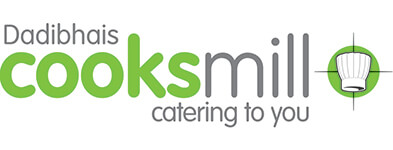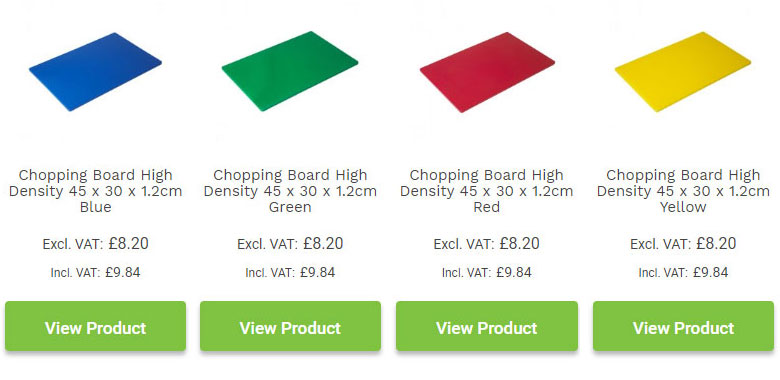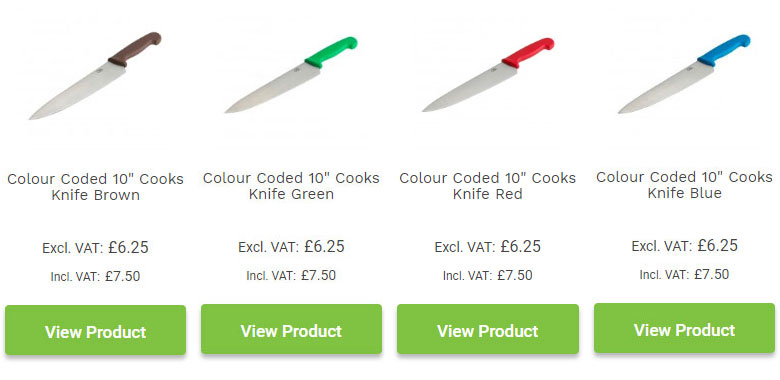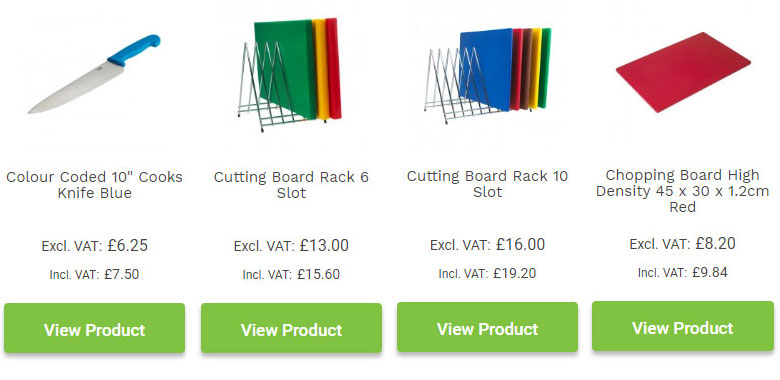Ultimate Guide to Colour Coded Chopping Boards

Plastic colour-coded chopping boards can help avoid cross-contamination of food in your kitchen.
As an essential part of any food preparation area or professional kitchen, colour-coded chopping boards safeguard your kitchen hygiene and ensure raw and cooked foods do not transfer bacteria.
Colour-coded chopping board sets are used by professional chefs and promote best practice food hygiene in the workplace. Although home kitchens may not necessarily need a full chopping board set, Cooksmill recommends that home cooks invest in two plastic boards (yellow & red) to help reduce the risk of cross-contamination from harmful bacteria to you and your family.
What are the different coloured chopping boards used for?
What are the recommended chopping board colours for food safely? Different colour-coded chopping boards are used to separate different types of food groups, for example, raw and cooked meat. The use of bold and easily identifiable colours provides chefs and kitchen staff the ability to quickly identify the correct chopping board for the job. From vegetable preparations to carving cooked meat, colour-coded boards promote strong kitchen hygiene practices.
- Red = Raw Meat
- Blue - Raw Fish
- Yellow = Cooked Meats
- Green = Fruits & Salad
- Brown = Vegetables
- White = Dairy & Bakery
Colour coded chopping boards chart
There are 6 different colour-coded chopping boards. Our graph below clearly matches each board to the correct food groups that are recommended by the Food Standards Agency in the UK. This makes the chopping board colour code easy to remember: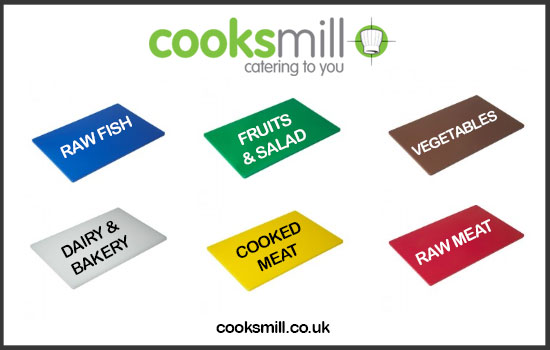
- The WHITE chopping board is used for bakery and dairy products. This may include, slicing freshly cooked bread or grating cheese.
- The YELLOW chopping board is used for cooked meats. This may include carving a Sunday roast joint or freshly cooked chicken.
- The BROWN chopping board is used for root vegetables such as potatoes, parsnips or turnips. Remember: brown = any earthy foods.
- The RED chopping board is used for raw meats only. This may include preparing pork crackling or deboning a chicken.
- The BLUE chopping board is used for raw fish only. Sometimes called a ‘fish chopping board’, blue boards can be used for descaling a salmon or removing small bones in a fish fillet.
- The GREEN chopping board is used for salad, fruit and fresh vegetables. This may include preparing salad, slicing tomatoes or dicing fruit. Remember: green = anything fresh and fruity.
Remember, you need a yellow meat chopping board for cooked meats and the raw meat chopping board colour is red.
What do you use a brown chopping board for?
Plastic brown chopping boards are used for the preparation of root vegetables. This may include cutting carrots, slicing sweet potatoes or dicing butternut squash. Brown chopping boards should be washed with warm soapy water and replaced when the board becomes deeply scored. High-density brown chopping boards are most suited for commercial kitchens due to their thickness and long life durability.
What about purple chopping boards?
Cooksmill are currently working hard to incorporate a range of ‘free-from’ chopping boards on the website. Watch this space! However, if you are a commercial kitchen or caterer looking for large quantities of plastic purple chopping boards, please email our team via info@cooksmill.co.uk.
You may have seen a purple board work its way into colour-coded chopping board kits. It’s a relatively new introduction to the set, and here’s what you need to know:
The PURPLE board is used for ‘free from' foods such as gluten-free bread or flour mixes.
The board has been introduced to help cater for people with conditions such as Celiacs. 50 years ago, only around 0.2% of the population in the UK suffered, but now it’s estimated that around 1 in 100 people in the UK are allergic to gluten. Over the last few years, there has also been a rise in the number of people adopting gluten-free diets for health reasons. Whether the person is allergic or is choosing to avoid gluten, it’s important for your business to be able to cater for their dietary requirements. Plastic purple chopping boards can significantly reduce the risk of gluten contamination in your kitchen or cafe.
Should I have different coloured chopping boards?
The main reason to use different coloured chopping boards for different foods is to stop cross-food contamination. This one’s a biggie because cross contamination of different food types can lead to food poisoning (something you absolutely do not want in your home, restaurant or cafe).
As well as preventing a food poisoning outbreak, using colour coded chopping boards can help cater to particular allergies. If you keep your different food types on different chopping boards, you’re significantly less likely to end up serving chicken with traces of shellfish to a customer who has a shellfish allergy! UK hospital admissions due to anaphylaxis has increased by a whopping 615% over the last 20 years, making it essential that your customers and dinners know that you’ve taken every precaution to prevent an allergic reaction and cross-contamination of food.
Using a universal colour code for the different foods makes it easy to distinguish the intended use for the board at a glance and for professional chefs to walk into a new kitchen and immediately know what’s what.
The code can also be extended to other kitchen items like colour-coded knives and cleaning equipment, and although it’s not the law to have colour coded kitchenware, it’s a system that every commercial kitchen and home cook should adopt to ensure food hygiene standards are the best the can be.
High density vs low density chopping boards
Colour coded chopping boards are made from two different types of polyethylene plastic: high-density polyethylene (HDPE) and low-density polyethylene (LDPE). Both types of plastic chopping boards are used widely by chefs and caterers in professional kitchens and food prep areas.
In short, although high-density boards are slightly more expensive, they offer much more durability than their low-density comparisons and are more widely used in commercial environments. Low-density boards offer a cheaper alternative to ensure best practice food hygiene standards are met however, low-density boards may have to be replaced more frequently depending on their volume of use in kitchens and catering areas. You might be wondering which type of food preparation chopping board is the one for you? Deciding which is the best chopping board will be easier after you have read our simple guide below.
What’s the difference?
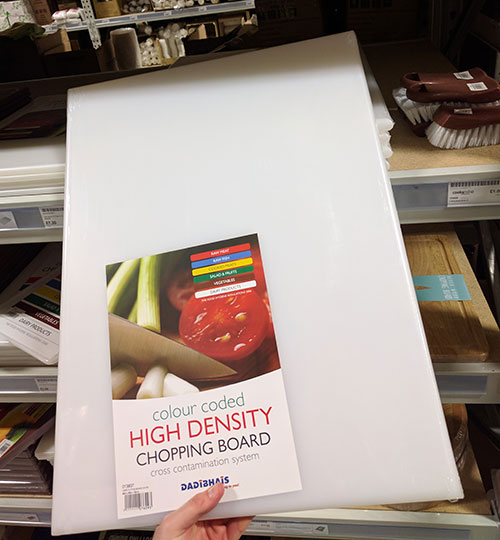
High-density colour coded plastic chopping boards offer:
- Much more durability than low-density boards and therefore are perfectly suited for busy commercial kitchens and restaurants.
- More resilience to knife scratches and warping due to deeper thickness. With board thicknesses ranging from 1.2cm to 1.9cm, high-density boards are built to last!
- The ability to be washed and dried in a commercial dishwasher.
However high-density chopping boards are:
- Much heavier than low-density and may not be suitable for ALL kitchens types.
- More expensive than LDPE boards due to their durability.
- More at risk of food contamination (if they’re not looked after properly) due to being used for longer in kitchens and food prep areas.
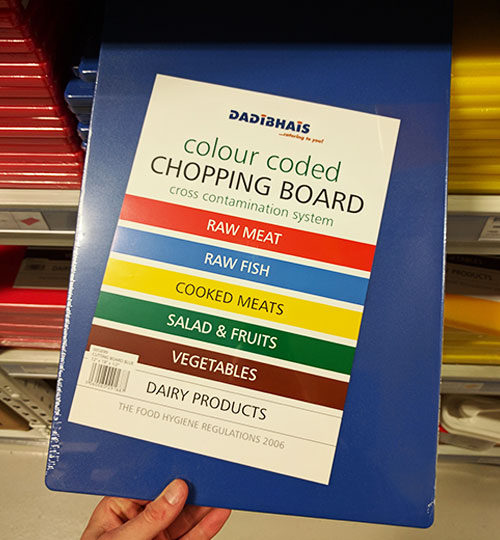
Low-density plastic chopping boards are:
- Much lighter and easier to carry around kitchens. LDPE boards can therefore be stored on smaller shelves in food prep environments.
- Nearly 50% cheaper than high-density boards.
- Replaced more often which reduces the risk of food contamination in food prep areas.
However low-density chopping boards are:
- Less durable than HDPE boards as they are not as thick or strong.
- More prone to knife scratches as the polyethylene plastic is less dense.
- Prone to bending and warping so need to be removed from a commercial dishwasher before the drying cycle. Please note: LDPE boards are best left to air dry.
Plastic chopping boards should be replaced when knife grooves become too deep. Deeply scored plastic chopping boards run the risk of hiding harmful bacteria in their grooves which does not get removed when thorough cleaned (even in commercial washers). When deep grooves appear, Cooksmill recommends replacing the board to keep your food preparations safe and bacteria free.
Colour-coded chopping board hygiene poster
Do you work in a commercial kitchen or food preparation area such as a factory or restaurant?
Do you need a chopping board hygiene poster for your wall? Our handy will poster will help your staff remember which colour board to use.
Please feel free to download and print off Cooksmill’s very own colour-coded chopping board hygiene poster for kitchens & food preparation areas. It’s 100% FREE and has been formatted in A4 size.
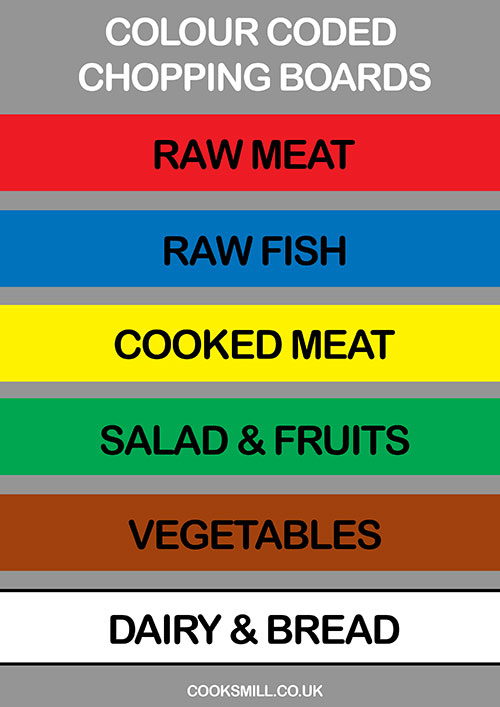
Taking care of your plastic chopping boards
So now you’ve figured out which density of chopping board suits your needs the best, how can you best take care of them so you can get more cut for your cash?
You can put your colour coded chopping boards in the dishwasher, but especially with low-density plastic, you need to watch out for potential warping. Boards will warp over time, but to avoid unnecessary warping, take your boards (especially low-density ones) out of your dishwasher after the wash has finished (before it switches to the dry cycle).
If you don’t want to use a dishwasher (or don’t have one), wash your boards thoroughly with warm, soapy water (making sure you wash both sides).
Once they’ve been washed, never use a tea towel to dry your chopping boards. Why? Because tea towels are a breeding ground for bacteria. Bacteria that you’re now spreading all over your lovely, clean boards. We recommend using a paper towel to dry your boards, or simply leaving them to air dry on a clean rack. chopping board colo
When storing your chopping boards, use a rack that keeps the boards from touching. Having the boards touching undermines the entire process of using separate boards in the first place! Plus, allowing air to flow around the boards helps keep them dry and clean so you don’t need to wash them before using them again.
When should I replace my chopping boards?
- When it’s covered in deep knife scores
Even if the scores aren’t deep enough to actually reach the other side of the board, deep knife scratches are the perfect hiding place for bacteria. Even a dishwasher will struggle to clean really deep scores.
- When it no longer sits flat on your surface due to warping
Once a plastic chopping board has warped to the point of not sitting flat on your work surface, it becomes dangerous. You’re using these boards to chop with pretty sharp knives and the last thing you want is for the board to move, ending in you slicing cleanly through your finger (instead of the intended carrot or spud).
Where to buy colour coded chopping boards in the UK
Look no further! Cooksmill offer a wide range of colour-coded chopping boards including high-density and low-density plastic boards and racks online. We have all of the required chopping board colours in stock. Most cooking shops in the UK now stock sets and individual boards however our prices are the cheapest you will find! Best of all, we offer FREE next working day delivery on orders over £50 ex VAT.
We also also an extensive range of wooden chopping boards and glass chopping boards.
How to shop with Cooksmill
There are thousands of items available in our online shop with quick delivery! Alternatively we also offer free collection from store and free delivery on all orders over £50.
Sign up toCooksmill's Newsletter!
Receive all the latest offers, competitions, new products, and current blogs.
